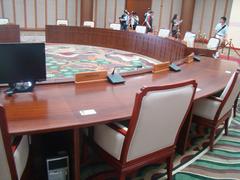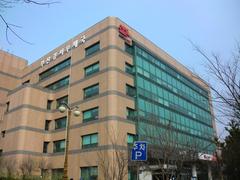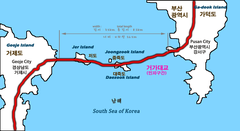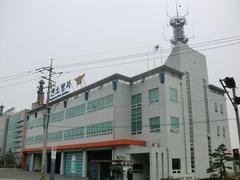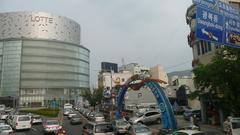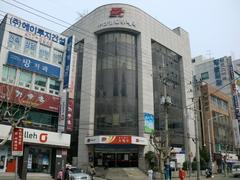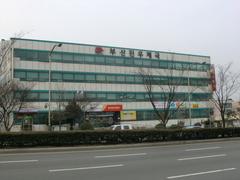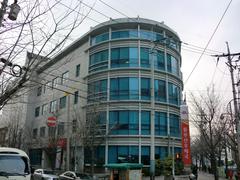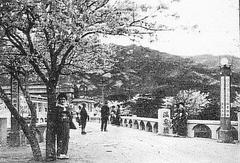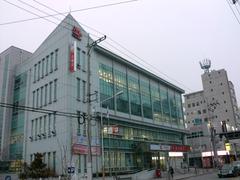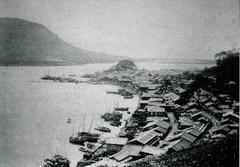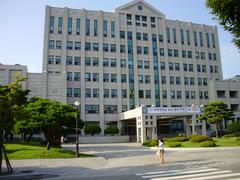
Busanjin Police Station Visiting Hours, Visitor Guide, and Historical Significance in Busan
Date: 03/07/2025
Introduction
Busanjin District, at the vibrant core of Busan, South Korea, represents a captivating fusion of historical legacy, rapid urbanization, and modern cultural dynamism. While the district is renowned for its bustling shopping centers and markets, its origins trace back to a strategic military outpost during the Joseon Dynasty. Today, Busanjin is not only a commercial and cultural hub but also a place where visitors can experience both Korea’s historic roots and its contemporary energy (TripJive, KoreaTripGuide).
At the heart of public safety and community support in this thriving area is the Busanjin Police Station. Though not a tourist attraction, the station is an essential resource for residents and international visitors alike, offering law enforcement, emergency assistance, multilingual support, and community outreach (Korean National Police Agency, Busan City Official Site).
This detailed guide covers Busanjin District’s historical evolution, cultural highlights, and practical information for visiting Busanjin Police Station—including accessibility, services, and safety tips. It also introduces related attractions like Busan Tower to round out your Busan travel experience.
Contents
- Introduction
- Historical Background of Busanjin
- Strategic Importance in Korean History
- Japanese Colonial Era and Urban Transformation
- Busanjin During the Korean War
- Modern Development and Identity
- Busanjin Police Station
- Institutional Background and Community Role
- Visitor Information
- Services and Accessibility
- Cultural Considerations
- Safety Tips for Tourists
- Practical Guide for International Visitors
- Related Attraction: Busan Tower
- Summary and Recommendations
- Sources
1. Historical Background of Busanjin
Strategic Importance in Korean History
Busanjin’s origins lie in its role as a military garrison (“jin”), safeguarding Korea’s southeastern coast. During the Joseon Dynasty, the Busanjin Fortress (Busanjinseong) was constructed as a bulwark against invasions, especially Japanese pirate raids and during the Imjin War (1592–1598). Today, while the fortress itself no longer stands, historical markers throughout the district commemorate its past (TripJive).
Japanese Colonial Era and Urban Transformation
After Busan’s opening as a treaty port in 1876, Busanjin developed rapidly. Under Japanese colonial rule (1910–1945), it transitioned from a military outpost to an administrative and commercial center. Remnants of colonial architecture remain, offering insight into this era (KoreaTripGuide).
Busanjin During the Korean War
During the Korean War, Busan served as a temporary capital and sanctuary, with Busanjin as a key site for humanitarian and logistical support. The district’s infrastructure expanded rapidly to accommodate refugees and public services, including the establishment of the Busanjin Police Station (KoreaTripGuide).
Modern Development and Identity
Modern Busanjin is characterized by its commercial vibrancy, notably in areas like Seomyeon and Bujeon Market. The district blends historical significance with a cosmopolitan urban lifestyle, hosting cultural festivals and events throughout the year (Road Affair, Hey Roseanne).
2. Busanjin Police Station: Institutional Background and Community Role
Historical Background and Development
Busanjin Police Station operates under the Korean National Police Agency (KNPA), established in 1991. Its evolution mirrors Busan’s transformation from a regional port to a major metropolitan city with over 3.5 million residents (Korean National Police Agency, Busan City Official Site).
Core Functions
- Law Enforcement: Maintaining public order, crime prevention, and responding to emergencies.
- Community Engagement: Organizing safety campaigns, educational programs, and collaborating with local organizations to foster trust and inclusivity.
- Tourist Support: Providing assistance to international visitors, including multilingual support and guidance in emergencies (Busan Tourism Organization).
- Crisis Management: Coordinating with fire and medical services for effective emergency response (Travel Safety Tips).
3. Visitor Information: Practical Guide
Location and Accessibility
- Address: Centrally located in Busanjin District, near Seomyeon and Bujeon neighborhoods.
- By Subway: Closest stations are Seomyeon (Lines 1 & 2) and Bujeon (Line 1). Both are within a 10-minute walk (Mapcarta).
- By Bus: Numerous city buses serve stops in the area.
- By Taxi: Simply state “Busanjin Police Station” (부산진경찰서) or show the address in Korean.
- On Foot: Easily accessible if staying nearby in Seomyeon or Bujeon.
Visiting Hours
- Open: 24 hours for emergencies.
- Recommended for Non-Urgent Visits: 9:00 AM–6:00 PM on weekdays (Busan Metropolitan Police Agency).
Services Available
- Emergency Assistance: Dial 112 for immediate police help.
- Lost & Found: Report and retrieve lost items; English support available during business hours.
- General Inquiries: Assistance with administrative issues, reports, and guidance.
- Tourist Support: Help with safety concerns, reporting incidents, and lost property.
Language Support
- English: Basic proficiency among officers; translation services available if needed.
- Other Languages: Translation apps and the Korea Travel Hotline (1330) can assist (In My Korea).
Accessibility
- Facilities: Ramps, elevators, and accessible restrooms.
- Additional Support: Notify staff in advance for special assistance.
Required Documentation
- Visitors: Passport or a copy for official matters.
- Residents: Alien Registration Card (ARC) if applicable.
4. Cultural Considerations and Safety Tips
- Etiquette: Dress modestly, be polite, and follow instructions. Avoid photography inside without permission.
- Safety: Busan is generally safe; remain vigilant against petty theft in crowded areas.
- Conduct: Provide clear information and address officers respectfully (“경찰관님” - gyeongchalgwan-nim) (The Sunrise Dreamers).
5. Practical Tips and Contact Information
| Aspect | Details |
|---|---|
| Location | Busanjin District, near Seomyeon and Bujeon (Mapcarta) |
| Subway Access | Seomyeon (Lines 1 & 2), Bujeon (Line 1) |
| Bus Access | Multiple city bus routes; stops in Seomyeon/Bujeon area |
| Hours | 24/7 for emergencies; 9:00 AM–6:00 PM for non-urgent matters |
| Emergency Numbers | 112 (police), 119 (fire/medical), 1330 (tourist hotline) |
| Language Support | Basic English; translation available |
| Accessibility | Ramps, elevators, accessible restrooms |
| Documentation | Passport, ARC (if applicable) |
| Nearby Amenities | Seomyeon shopping, Bujeon Market, restaurants, cafes, public transport hubs |
Emergency and Non-Emergency Numbers
- Police Emergency: 112
- Fire/Medical Emergency: 119
- Korea Travel Hotline: 1330 (Lonely Planet)
6. Frequently Asked Questions (FAQ)
Q: Is Busanjin Police Station open 24 hours?
A: Yes, it operates around the clock for emergencies. For general inquiries, visit between 9:00 AM and 6:00 PM on weekdays.
Q: Are there tours or tickets required?
A: No, the station is not a tourist attraction and requires no tickets or entry fees.
Q: Can I get help in English?
A: Basic English support is available; translation services can be arranged if needed.
Q: Are the facilities accessible?
A: Yes, there are ramps, elevators, and accessible restrooms.
Q: How do I report a lost item?
A: Visit the station during business hours and provide details of your lost belongings.
7. Related Attraction: Busan Tower
Introduction
Busan Tower, located in Yongdusan Park, is a must-visit for panoramic views of the city. Built in 1973 and standing 120 meters tall, it symbolizes Busan’s growth and modernity (Busan Metropolitan City Tourism).
Visitor Information
- Opening Hours: 10:00 AM–10:00 PM (last admission 9:30 PM)
- Tickets: Adults 8,000 KRW; Youth 5,000 KRW; Children 3,000 KRW; free for under 7/seniors over 65
- Access: Subway to Nampo Station (Line 1, Exit 7); walk to Yongdusan Park.
- Nearby: Jagalchi Fish Market, BIFF Square, Gukje Market
- Accessibility: Ramps, elevators, and accessible facilities
Tips
- Wear comfortable shoes for walking in the park.
- Visit on clear days for the best views.
- Yongdusan Park is free; only the tower requires a ticket.
8. Summary and Recommendations
Busanjin District exemplifies the convergence of Korea’s rich history and modern vibrancy. Whether you’re delving into local markets, exploring historical markers, or in need of support at Busanjin Police Station, the district offers a multifaceted experience. The police station is a pillar of community safety—approachable, accessible, and supportive for both residents and international visitors (Korean National Police Agency, Busan Tourism Organization).
Plan your visit with reliable resources, and consider downloading the Audiala app for up-to-date guides and safety alerts. Explore Busan’s other attractions like Busan Tower to make your journey even more memorable.
9. Sources
- TripJive - Busan Hidden Museums & Historic Gems
- KoreaTripGuide - Historical Landmarks in Busan
- Road Affair - Visiting Busan Guide
- Hey Roseanne - Things to Do in Busan
- Korean Topik - Tragic Busan Apartment Fire
- Korean National Police Agency
- Busan City Official Site
- Busan Metropolitan Police Agency
- Busan Tourism Organization
- Travel Safety Tips (The Broke Backpacker)
- Mapcarta - Busanjin Police Station Location
- Lonely Planet - Things to Know Before Traveling to South Korea
- In My Korea - South Korea Travel Guide & Korean Travel Tips
- Busan Metropolitan City Tourism - Busan Tower


